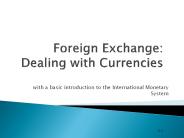Foreign Exchange and the International Monetary System
1 / 19
Title:
Foreign Exchange and the International Monetary System
Description:
Title: International Monetary System Author: Fiona Maclachlan Last modified by: Manhattan College Created Date: 12/4/2003 2:23:35 AM Document presentation format – PowerPoint PPT presentation
Number of Views:13
Avg rating:3.0/5.0
Title: Foreign Exchange and the International Monetary System
1
Foreign Exchange and the International Monetary
System
- Chapters 19, 20
2
Foreign exchange market
- OTC (several hundred dealers, mostly banks)
- Wholesale vs. retail
- Transactions size 1 million or larger
- Daily volume in excess of 1 trillion/day
3
Purchasing Power Parity Theory
- A method of calculating exchange rates that
attempts to value currencies at rates such that
each currency will buy an equal basket of goods. - Creates a balance in trade. When a country has an
inflation, its currency depreciates.
4
Volatility in forex market not explained by PPT
- Purchasing power changes slowly.
- Most forex trading is not to finance
import/export traded.
5
Asset Demand Theory
- Exchange rates adjust so that expected returns
across assets of equal risk are equalized. - So if the expected return on European assets is
higher than ones in the U.S. assets, the value of
the Euro will appreciate. - In equilibrium all expected returns are equal.
6
19th Century Gold Standard
- 1 oz of gold 20 4
- 1 5
- Suppose 1 5.25.
- Whats the arbitrage opporunity?
- Liberty Gold Dollar (1849-1854)
7
Bretton Woods Agreement 1944
- Established a system of fixed exchange rates.
- Major architect of agreement J.M. Keynes called
gold a barbarous relic.
8
Nixon Closes the Gold Window (1971)
- 1960s inflation in US
- Accumulation of s in ROW
- German CB requests gold for s.
- Nixon refuses to honor agreement signaling the
beginning of the end of fixed exchange rates.
9
Exchange Rate Interventions
- Unsterilized
- CB enters into forex market to influence value
of currency. - E.g. Fed buys to keep value high.
- Sterilized
- CB enters into forex market and then conducts OMO
to keep money supply constant. - E.g. Fed buys in forex market and then conducts
expansionary OMO.
10
Effect of Interventions
- Evidence shows sterilized interventions have
little effect. - Consider, Germany during final years of BW.
- Buying dollars, selling DM and then buying DM to
prevent inflation. - No matter how many dollars they bought they
couldnt get the exchange rate at BW levels.
11
Debt Instruments
- Chapter 4
12
Present Value
- What is a future cash flow (FV ) worth now?
13
Rule of the Cash Flow Timeline
- Cash flows at the same date can be added
together, but cash flows at different dates
cannot be added together.
14
Four Types of Credit Market Instruments
- 1. Simple loan
15
2. Fixed Payment, or Amortized, Loan
- Examples car loans, mortgages
16
3. Coupon Bond
- Most bonds with maturities greater than a year
are of this form. - Coupons bonds issued by
- Federal government (Treasurys)
- State and local governments (munis)
- Corporations (corporates)
17
(No Transcript)
18
Special Type of Coupon Bond Consol or Perpetuity
- Fixed coupon received forever.
19
4. Discount, or Zero Coupon, Bond
- Identical in cash flow structure to a simple
loan. The difference is that theres an active
secondary market for zero coupon bonds.































